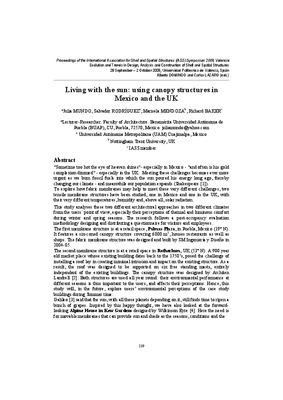JavaScript is disabled for your browser. Some features of this site may not work without it.
Buscar en RiuNet
Listar
Mi cuenta
Estadísticas
Ayuda RiuNet
Admin. UPV
Living with the sun: using canopy structures in Mexico and the UK
Mostrar el registro sencillo del ítem
Ficheros en el ítem
| dc.contributor.author | MUNDO, Julia
|
|
| dc.contributor.author | RODRIGUEZ, Salvador
|
|
| dc.contributor.author | MENDOZA, Marisela
|
|
| dc.contributor.author | BAKER, Richard
|
|
| dc.contributor.editor | Domingo Cabo, Alberto
|
es_ES |
| dc.contributor.editor | Lázaro Fernández, Carlos Manuel
|
es_ES |
| dc.date.accessioned | 2009-11-26T14:07:58Z | |
| dc.date.available | 2009-11-26T14:07:58Z | |
| dc.date.issued | 2009-11-26T14:07:58Z | |
| dc.identifier.isbn | 978-84-8363-461-5 | |
| dc.identifier.uri | http://hdl.handle.net/10251/6503 | |
| dc.description | p. 239-251 | en_EN |
| dc.description.abstract | "Sometime too hot the eye of heaven shines"- especially in Mexico - "and often is his gold complexion dimmed" - especially in the UK. Meeting these challenges becomes ever more urgent as we burn fossil fuels into which the sun poured his energy long ago, thereby changing our climate - and meanwhile our population expands (Shakespeare [1]). To explore how fabric membranes may help to meet these very different challenges, two tensile membrane structures have been studied, one in Mexico and one in the UK, with their very different temperatures, humidity and, above all, solar radiation. This study analyses these two different architectural approaches in two different climates from the users' point of view, especially their perceptions of thermal and luminous comfort during winter and spring seasons. The research follows a post-occupancy evaluation methodology designing and distributing a questionnaire for visitors and employees. The first membrane structure is at a retail space, Palmas Plaza, in Puebla, Mexico (19º N). It features a six-coned canopy structure covering 6000 m2, houses restaurants as well as shops. The fabric membrane structure was designed and built by SM Ingeniería y Diseño in 2004-05. The second membrane structure is at a retail space in Rotherham, UK (53º N). A 900 year old market place whose existing building dates back to the 1750¿s, posed the challenge of installing a roof lay in creating minimal intrusion and impact on the existing structure. As a result, the roof was designed to be supported on six free standing masts, entirely independent of the existing buildings. The canopy structure was designed by Architen Landrell [2]. Both structures are used all year round: their environmental performance at different seasons is thus important to the users, and affects their perceptions. Hence, this study will, in the future, explore users¿ environmental perceptions of the case study buildings during Summer time. Galileo [3] said that the sun, with all those planets depending on it, still finds time to ripen a bunch of grapes. Inspired by this happy thought, we have also looked at the forwardlooking Alpine House in Kew Gardens designed by Wilkinson Eyre [4]. Here the need is for movable membranes that can provide sun and shade as the seasons, conditions and the plants' needs vary. It was found from the users¿ perception of Palmas Plaza and Rotherham market that the membrane structures perform well in terms of luminous comfort and ventilation but not so well for thermal comfort, aesthetics or functionality. The Alpine House seems to perform well in all environmental factors and aesthetics of the movable membranes (Table 1). The potential of canopy structures to generate green energy through the exposure to solar radiation is also discussed: new materials and technologies allow harnessing energy from the available solar exposed surface. It was found that they can generate up to 534 MWh/yr in Mexico and 156 MWh/yr in the UK. | en_EN |
| dc.language | Inglés | en_EN |
| dc.publisher | Editorial Universitat Politècnica de València | es_ES |
| dc.relation.ispartof | Symposium of the International Association for Shell and Spatial Structures (50th. 2009. Valencia). Evolution and Trends in Design, Analysis and Construction of Shell and Spatial Structures : Proceedings | en_EN |
| dc.rights | Reserva de todos los derechos | en_EN |
| dc.subject | Environmental performance | en_EN |
| dc.subject | Post-occupancy evaluation | en_EN |
| dc.subject | Thermal and luminous comfort | en_EN |
| dc.subject | Users' environmental perception | en_EN |
| dc.subject | Fabric canopy structures | en_EN |
| dc.subject | Thin film solar cell | en_EN |
| dc.subject | Green energy | en_EN |
| dc.title | Living with the sun: using canopy structures in Mexico and the UK | en_EN |
| dc.type | Comunicación en congreso | en_EN |
| dc.rights.accessRights | Abierto | es_ES |
| dc.description.bibliographicCitation | Mundo, J.; Rodriguez, S.; Mendoza, M.; Baker, R. (2009). Living with the sun: using canopy structures in Mexico and the UK. Editorial Universitat Politècnica de València. http://hdl.handle.net/10251/6503 | es_ES |
| dc.relation.conferencename | Symposium of the International Association for Shell and Spatial Structures | es_ES |
| dc.relation.conferencedate | 2009 | es_ES |
| dc.relation.conferenceplace | Valencia | es_ES |






